The Wonderful “Blue City” of Jodhpur, India
Jodhpur is a beautiful city and a welcome relief from the hassles of India. The people here are for the most part friendly and casual. They sometimes call out for business, but they don’t pester or follow. People say hello on the street, particularly kids. Many of the buildings are hundreds of years old, painted in blue and white, and aging gracefully. The streets are narrow and winding, making it better for people and animals and worse for cars. Within the older part of town, very few cars dare go. Everywhere are shops and markets and people going about their business.
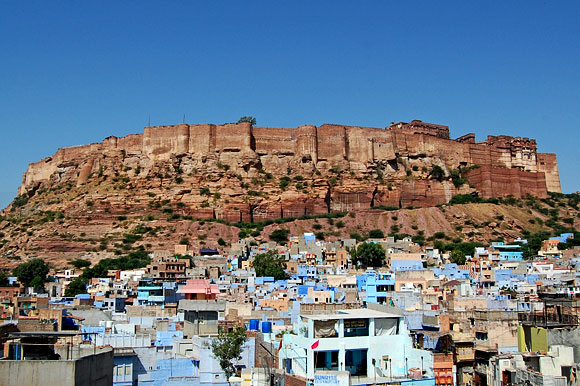
Meherangarh Fort seen from our guesthouse.
We arrived in Jodphur on Saturday around lunchtime, and were taken to our guest house by a honest and friendly auto rickshaw driver. It’s called Shivam Paying Guesthouse, and is run by a friendly man with dark circles around his eyes and paan stained teeth. Our room is 400Rs a night and has a loud air conditioner that consists of a screen of reeds that water drips over as a fan pushes air through. It works surprisingly well, but the fan blade sounds wobbly and dangerous. Like most of the town, we are in the shadows of the imposing 125m hill capped by the sprawling Meherangarh Fort. We ate our lunch from the rooftop deck. The fort was in front of us, on our sides and rear were the irregular rooftops of the town. Birds were swarming in the air. It was hot. On the street below, cows bellowed, motorbikes honked, bicycle bells dinged, and people chatted.
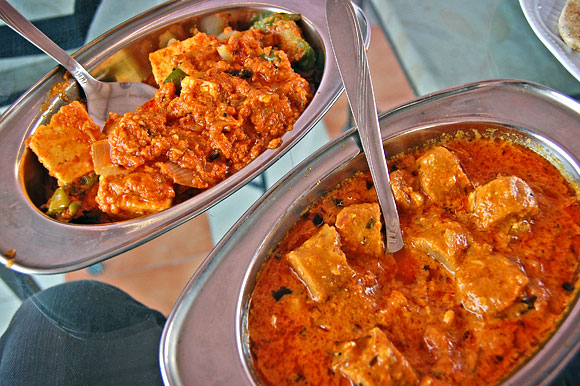
Our delicious Indian lunch. Not pictured: two huge mugs of lemon tea and iced coffee, naan.
It was time for us to wander a bit. The town is so continually captivating in its old buildings that it’s impossible to capture them all. Basically all have some amazing feature. Add the commotion on the street and all the interesting small shops, and photographing the place becomes a daunting ordeal. Needless to say, these photos capture only a hair off the full, lustrous head of this town.
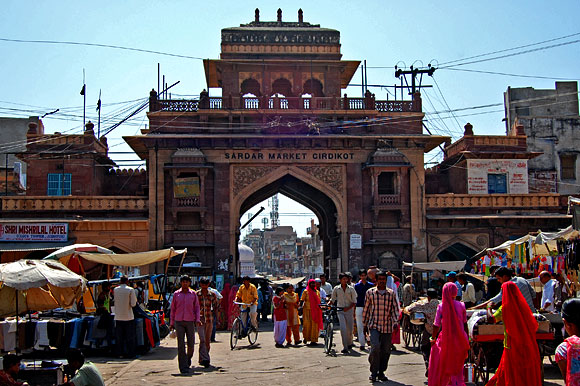
The main market near us is called Sardar. It’s walled off, with two gates, and contains the only clock tower in town.
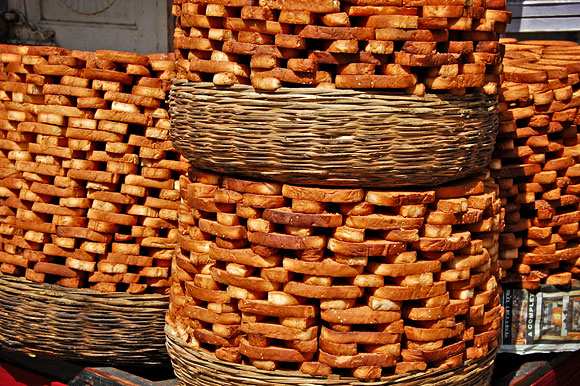
Stacks of toast for sale on a push cart. No one seemed to be buying it, and it’s easy to see why. This bread is exposed to all sorts of bugs, soot, and dust.
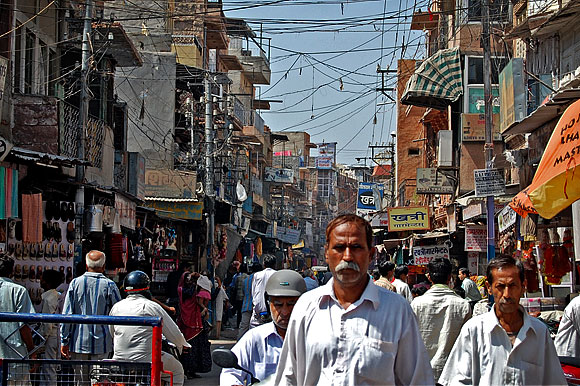
One of the main roads.
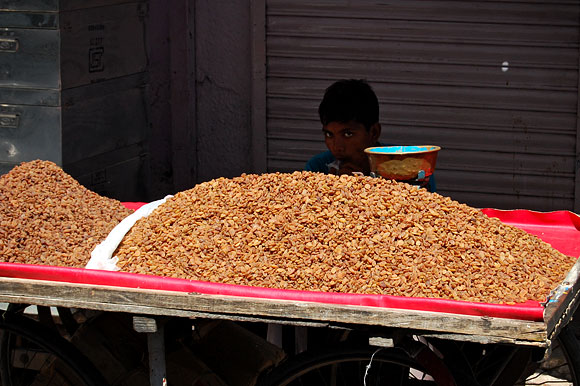
Raisin seller sitting in the shadows.
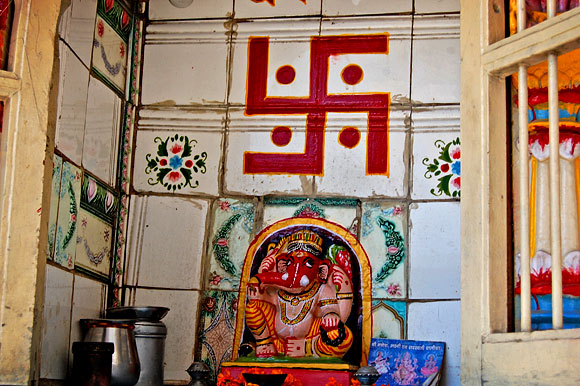
I didn’t know Vishnu was German.
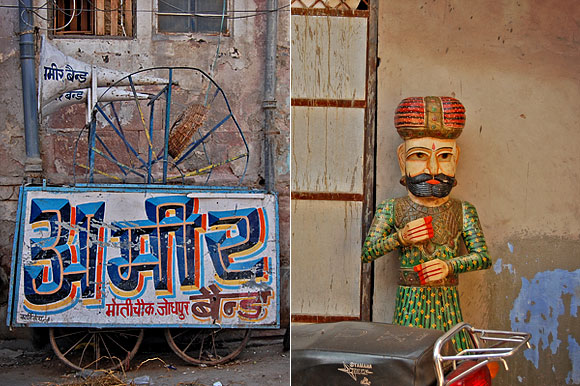
Cart with bullhorns and statue by door.
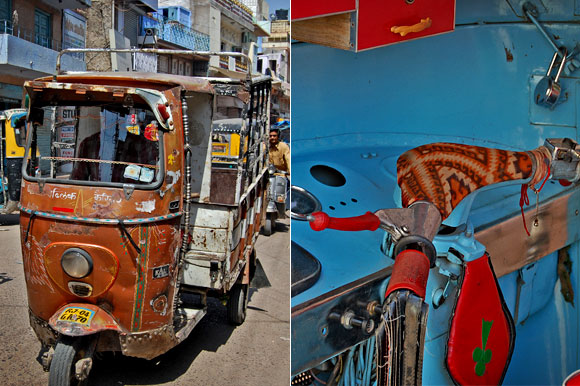
The auto rickshaws are sillier looking here. THe driver sits higher, looking through a small window that leans forward. His seat is on a ventilated case over the engine. There is more legroom in the back. Man of them are decorated inside and out and have a drawer for cash and smokes above the dash.
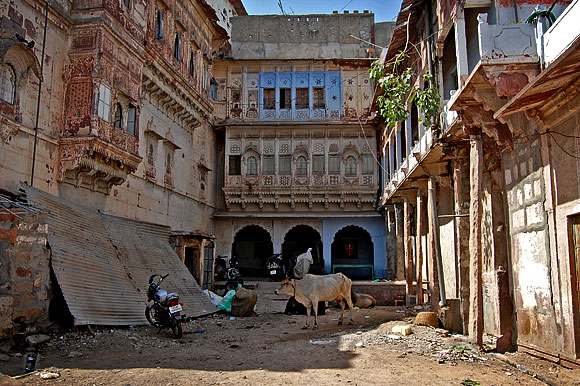
Cows and motorbikes parked inside the gate to an old home.
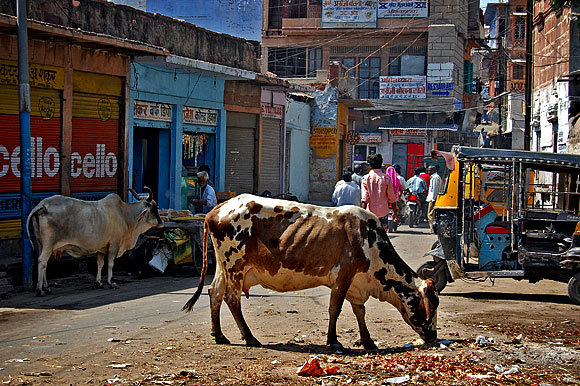
One cow eats garbage as another eyes a food cart.
My hair had gotten long and was causing needless heat-retention. I found a friendly barber who clipped it short with scissors and comb only using frantic Edward Scissorhands energy. He was skillful. Around my ears and at my nape, he edged with a straight razor. I turned down the straight razor shave, as it freaked me out. To complete the haircut, he massage my head and shoulders. Total cost: 30Rs(70¢), plus tip. Amazing.
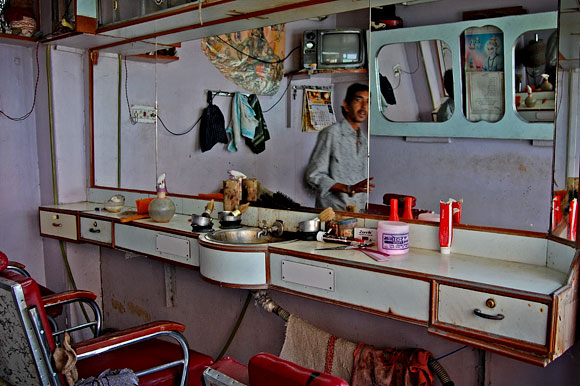
My Indian barber.
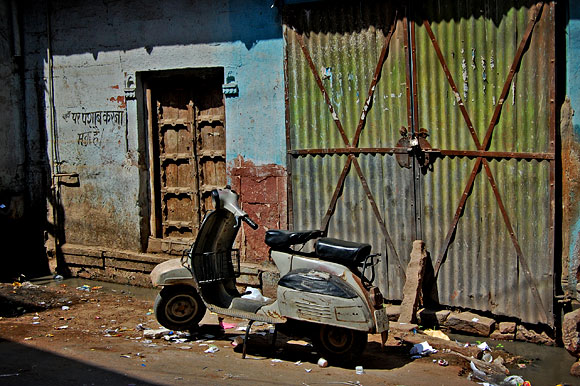
Everywhere in this town are old scooters parked by even older doors.
In the evening, we came back and had dinner on the roof as the sun set. A few large bats came out. Even though it was the first day, I knew I liked the place. It had a far better energy than Varanasi and Agra. It felt “nice.”

The clock tower at sunset. To the distant left is the palace of the maharaja’s family.

Sun setting over the hill.
After a hot night’s sleep, we got up early and ate breakfast while watching a huge flock of swifts getting hunted by hawks. We got some waters and headed up the hill to Meherangarh Fort. It was a short walk through the neighborhood, but hot. Hot. I was dripping in sweat when we got to the gates at 9AM. They were just opening. We paid our foreigner 250Rs($5.60) each and went inside.
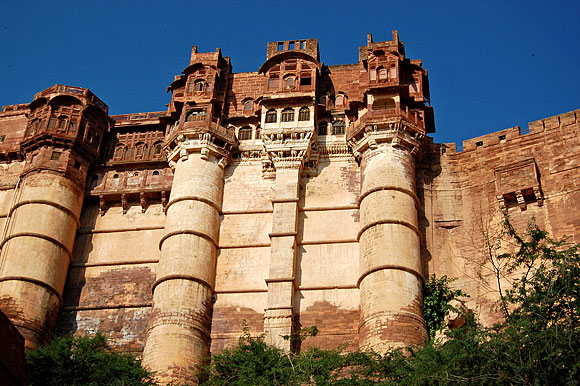
Meherangarh Fort seen from the hike.
Meherangarh Fort is massive, old, and amazing. There’s so much stone in it’s foundations that it would be imposing even without the natural hill. This was a functional fort, used for royal and war purposes. Canon ball dents are marked around the walls, much of the building has been well preserved or restored. But it’s also ornate and decorative. The inner structures are dripping with decorate stonework. It feels a bit like walking inside a wasp’s nest. The property is still in the care of the Maharaja’s family, though through a trust.
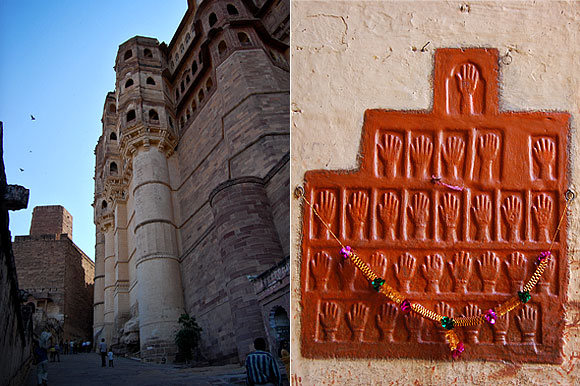
Inner ramp and towers, hand prints of the widows of the Maharaja.
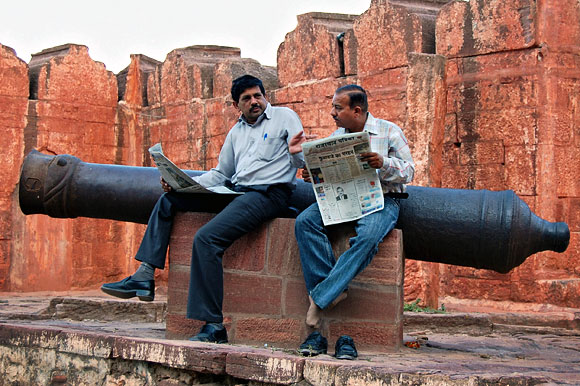
Two men discussing the news from their cannon.

New wall old wall.
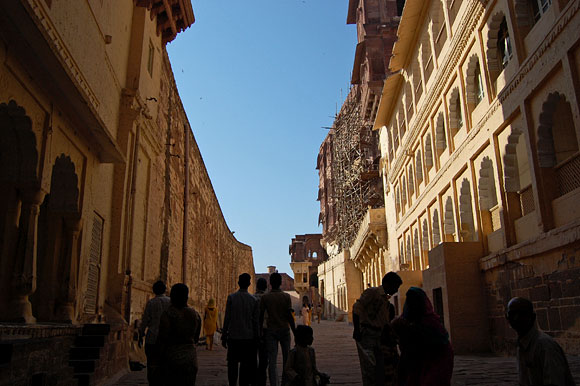
The ramp leading into the inner area of the fort.
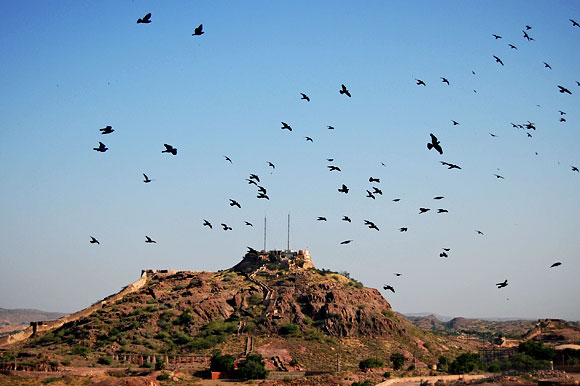
Birds swarming outside.

Decorative stone walls with man looking out a window.
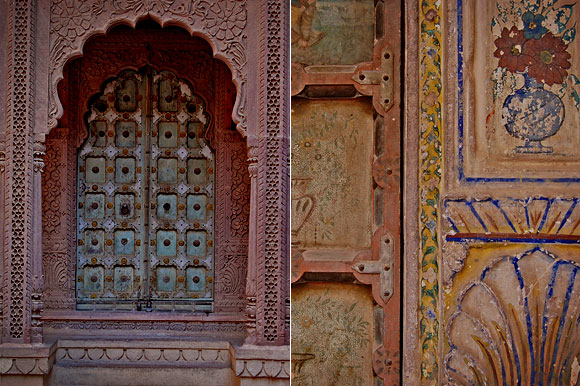
Decorate doors.
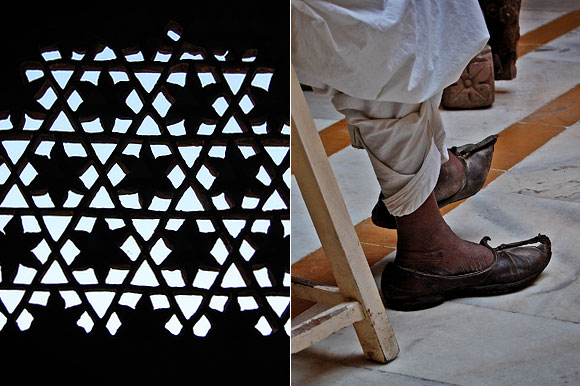
Window and shoes. The guard was picking his nose deeply. He seemed bored.

More decorate stone.
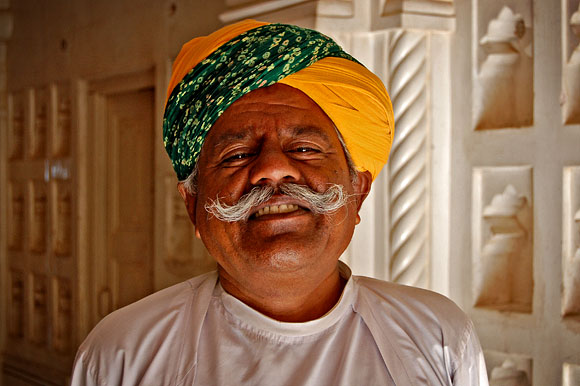
Guard.
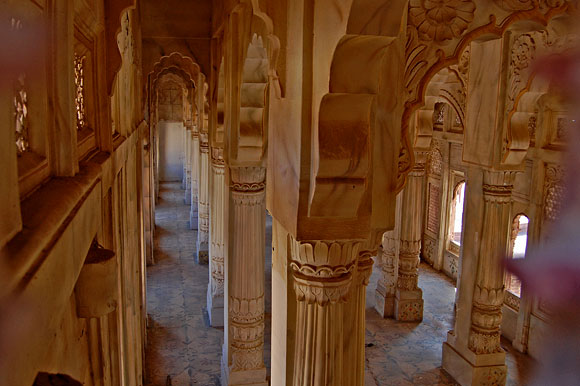
Sealed off room seen through a hole in the wall. Much of the fort was blocked off.

One of the ornate royal rooms. This one was dripping with gold and stones.
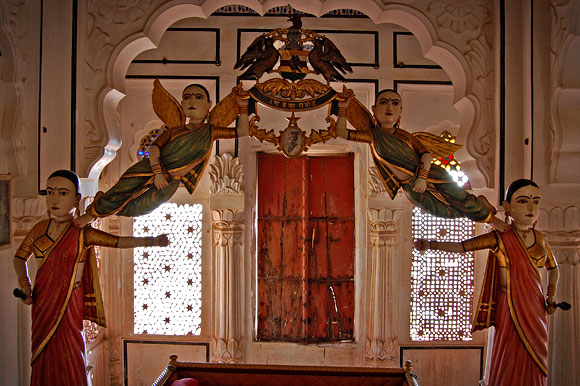
Arch ladies.
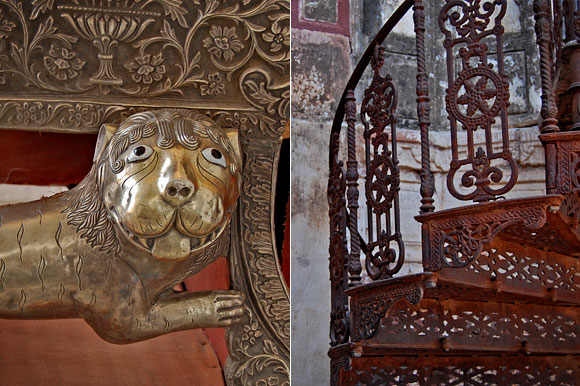
Dumb looking lion on a royal conveyance, iron stairs.
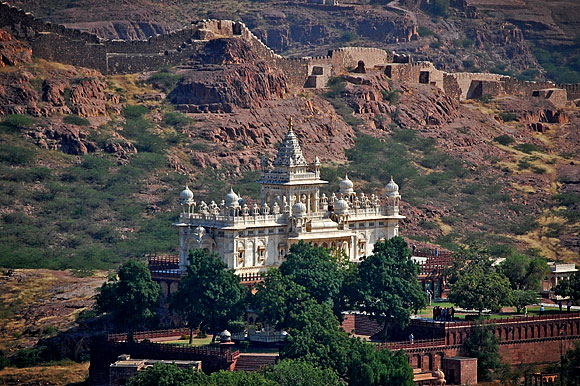
Jaswant Thada seen from the fort.
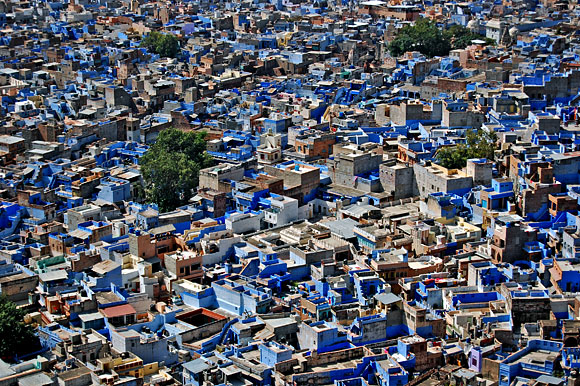
Blue Jodhpur seen from the ramparts of Meherangarh. Beautiful.
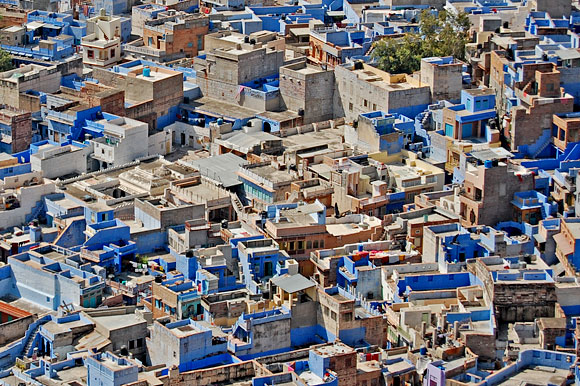
Detail.
Jodphur had a tragedy at Meherangarh a few days before our arrival. Thousands had come early to visit Chamunda Devi Temple at the south end of the fort. When the gates opened, hundreds of people were trampled. 400 died. The town was in mourning, and the fort was much quieter than it would have been at this time of year.
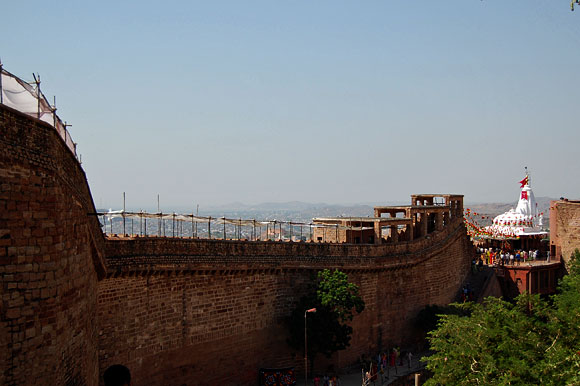
The walkway leading to Chamunda Devi Temple.
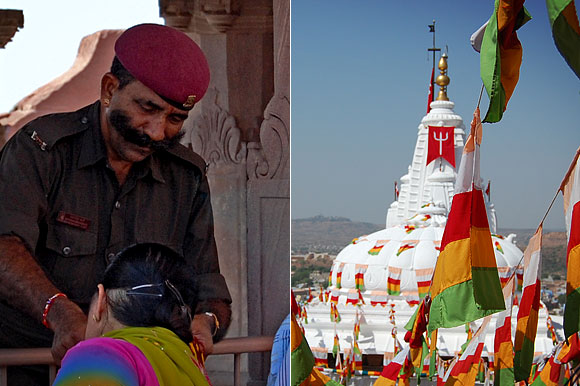
Man dishing out water, the temple.
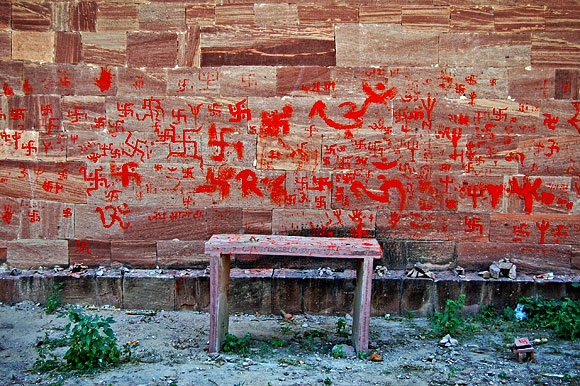
people leaving prayers with pigment at the base of the wall.
We descended the hill and explored the town some more.
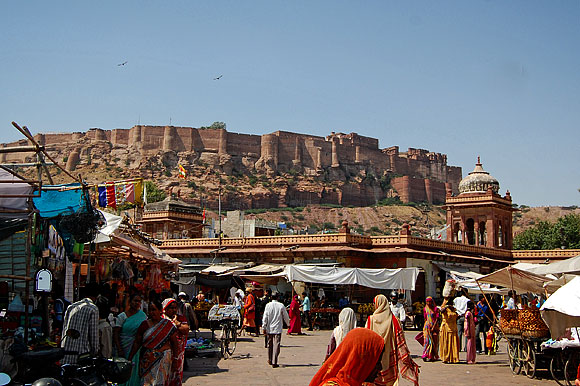
Fort seen from Sardar Market.
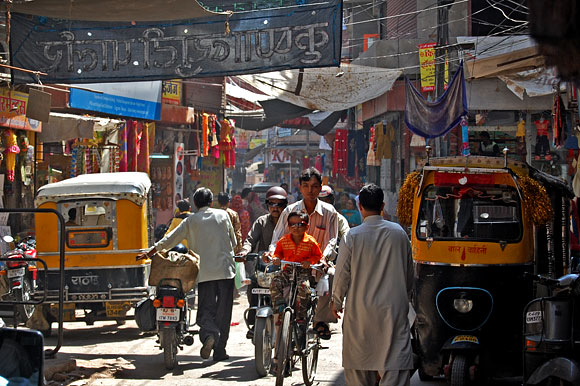
Clothes district.
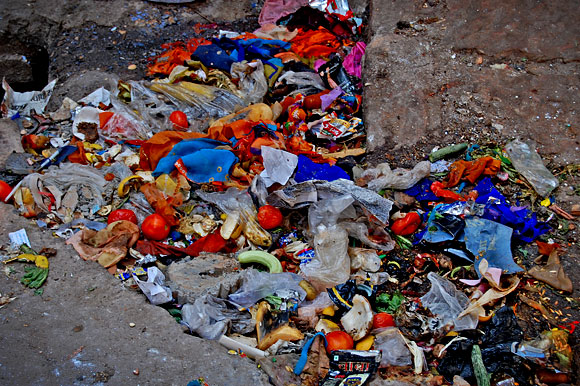
Street garbage.
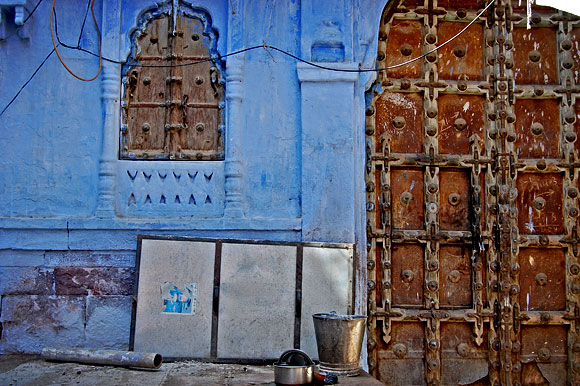
Blue wall, brown wood.
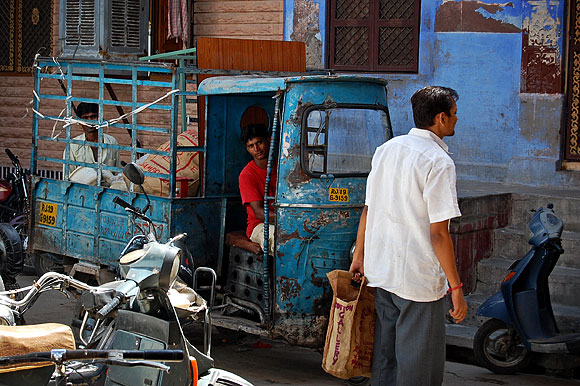
Man blocking traffic.
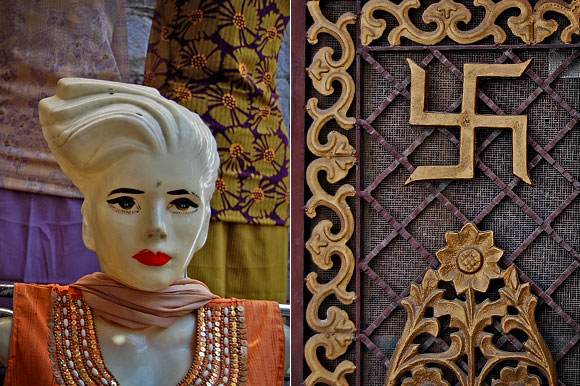
Wind blown mannequin and gate detail.
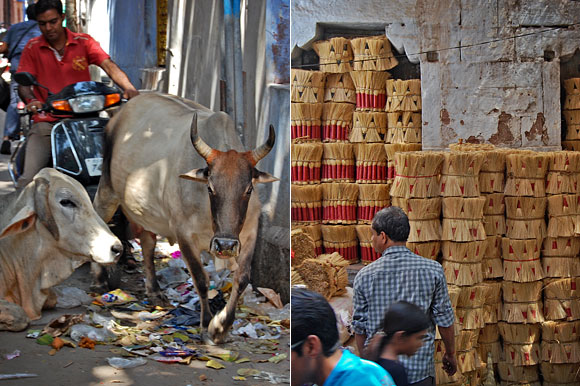
Cows blocking traffic and broom dealer.
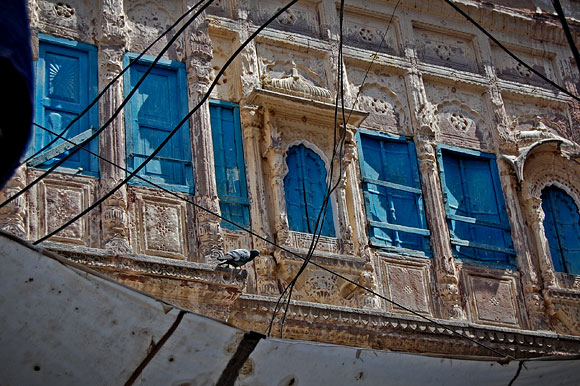
Old wall blue windows above the street.
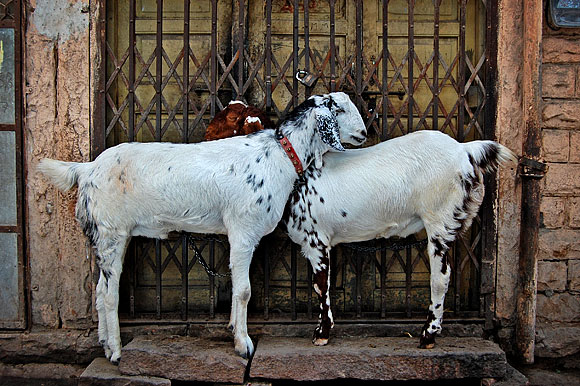
Symmetrical goats.

Yellow stuff.
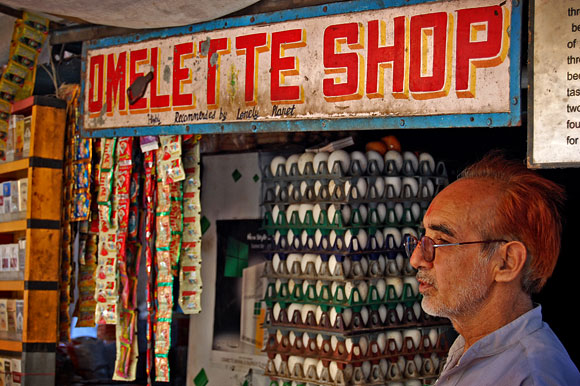
Omelette Shop near Sardar Market makes some great food. There may be poop on the egg shells, but the masala omelette I ordered was great. Two small sandwiches made with bread, vegetable and spice egg, mayo and ketchup. All for less than a dollar.
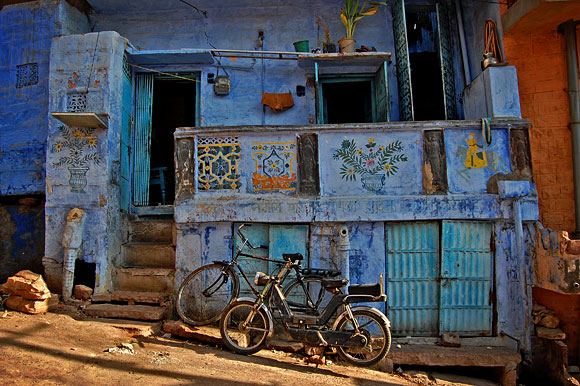
Blue building on a hill.
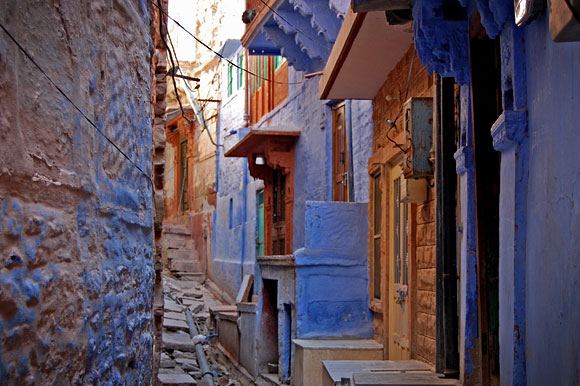
Narrow alley getting pipe repairs.
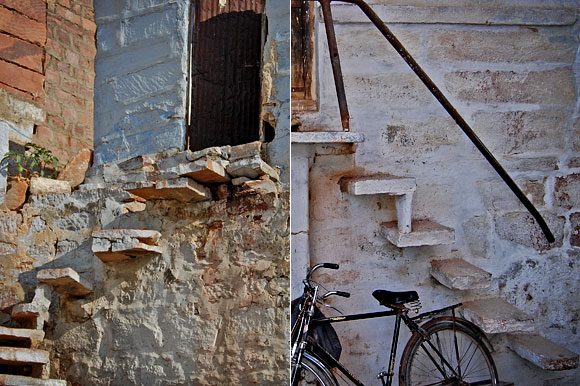
Two sets of stairs coming out of walls.
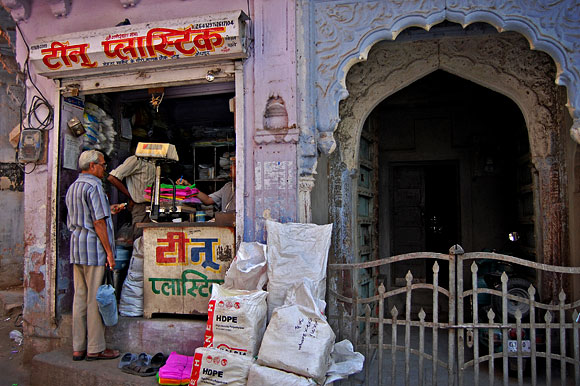
Cloth vendor.
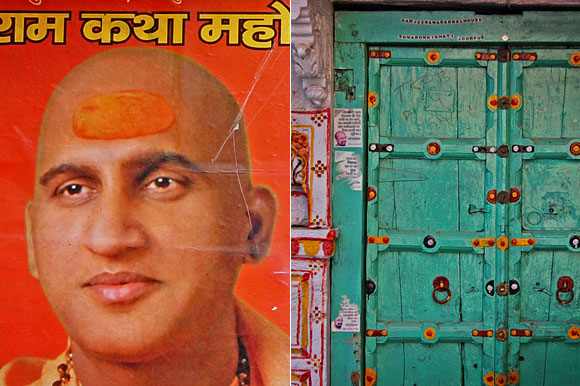
Posters of the man with jam on his head were all over town. Door.
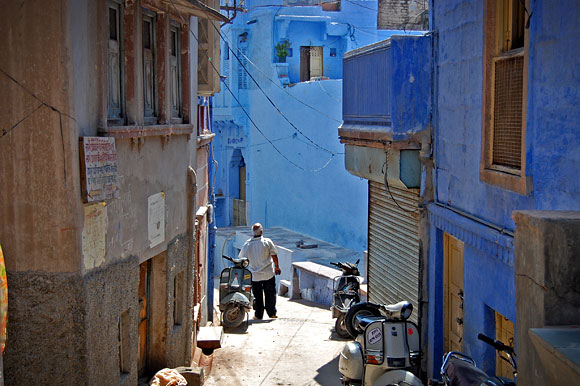
Old man walking.
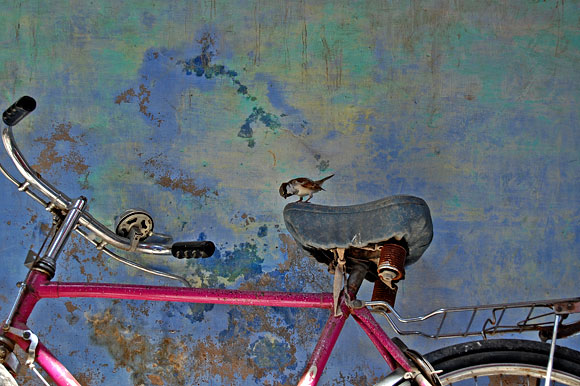
Bird on bike.
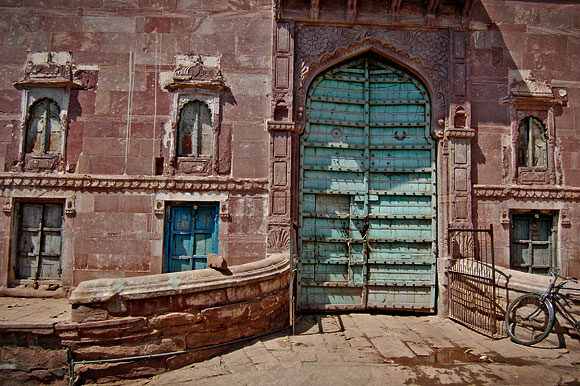
Another awesome old door. The next day, I was to find out what was inside this gate through a lucky encounter.
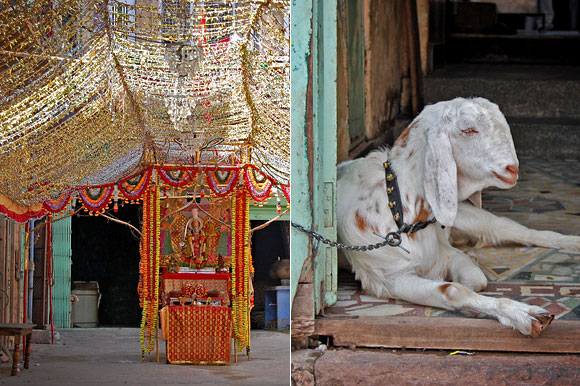
Altar, goat in doorway.
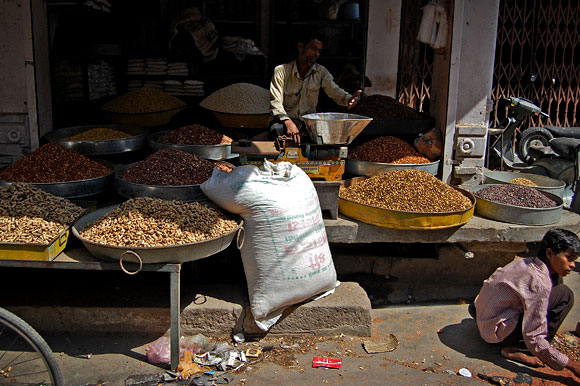
Beans, lentils, and legumes for sale.
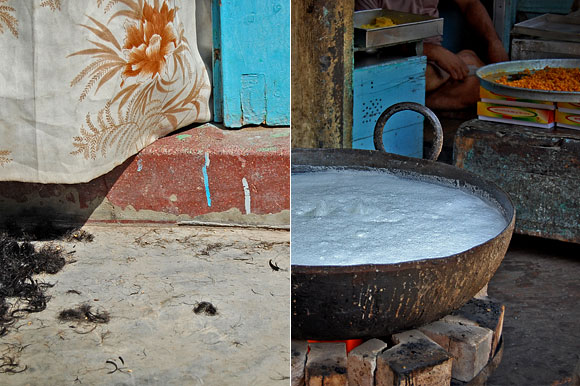
Hair trimmings, large boiling cauldron of milk.
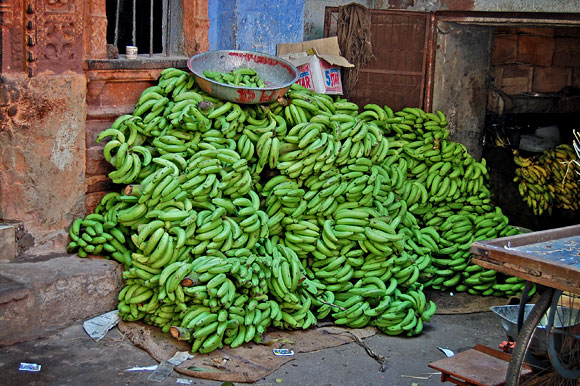
Street bananas.
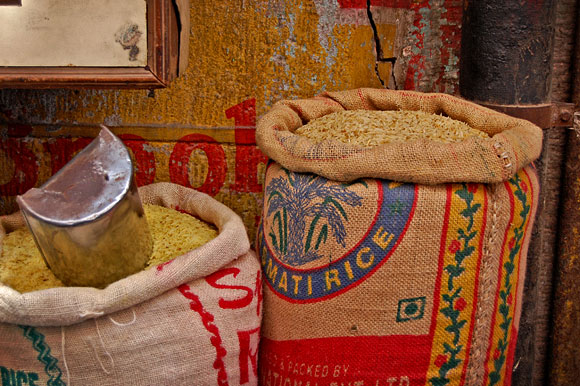
Rice.
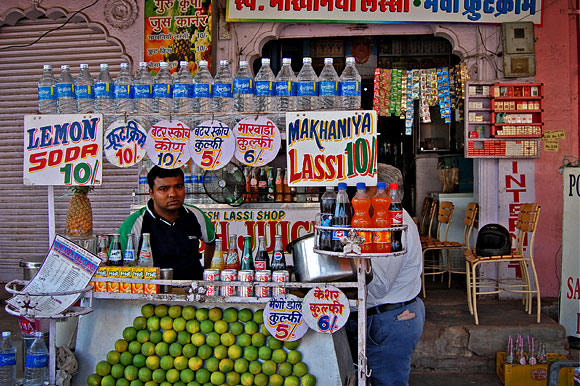
Drink vendor. His shop had seats outside and a wide menu of delicious drinks made to order from specials sodas to lassis, shakes, and juices. J. and I have tried a variety of things from his store: saffron lassi, pineapple shake, fresh lemon soda, and masala soda.
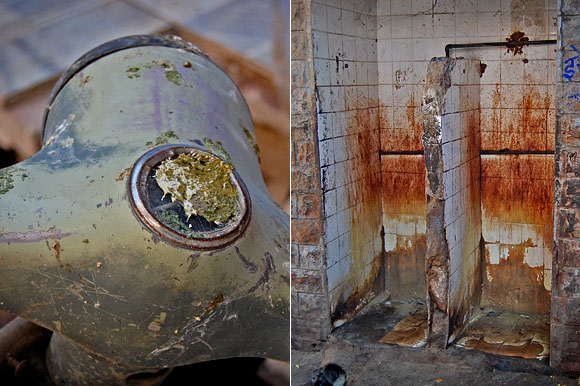
Pooped on scooter. Public urinals. The red band in the middle is from people spitting out paan juice.
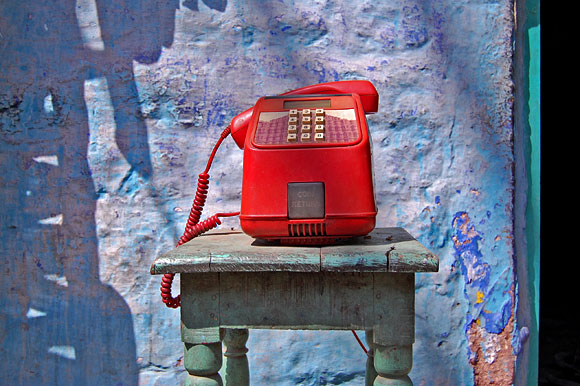
Jodhpur pay phone sitting outside a store.
In the evening, J. and I arranged for an Indian cooking class taught by a mother and owner of a spice shop near our guest house. The class was very informal and conducted in the cramped kitchen she uses for her family. It was just J. and I, so it was very easy to ask her questions about food and everything India. After teaching about the various kinds of spices, we took a trip to the nearby market to get produce. Then, she taught us how to make a wet curry paneer, a rice dish with a Jodhpur speciality called gutta (a dumpling made from chickpea flour and spices), saffron lassies, and pan fried paratha breads. The class lasted from 2 to 6PM, and cost 600Rs($13) each, plus an extra 100Rs for some perishable ingredients. It could have been a more comprehensive course, or more professional, but that would have been at the sacrifice of casualness. We were paying friends, and we got be inside a old home, cooking with old utensils, and asking questions about Jodhpur. That’s worth it to me. Plus, we got to eat the food. If you’re interested in taking the class, just talk to the people at Shubham Provision Store/Indian Spices. It’s across the intersection from the street Shivam Paying Guesthouse is on.
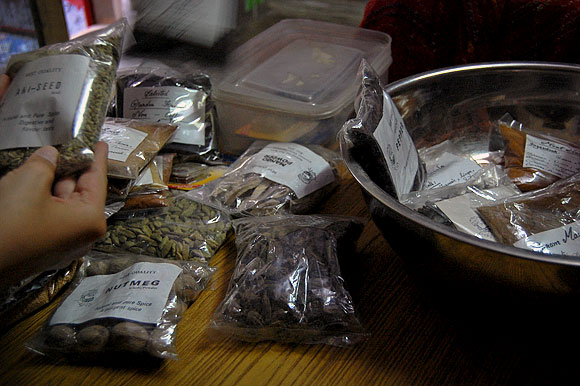
Talking spices.
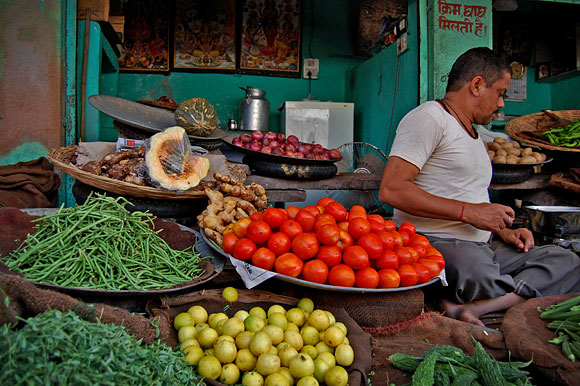
At the market.
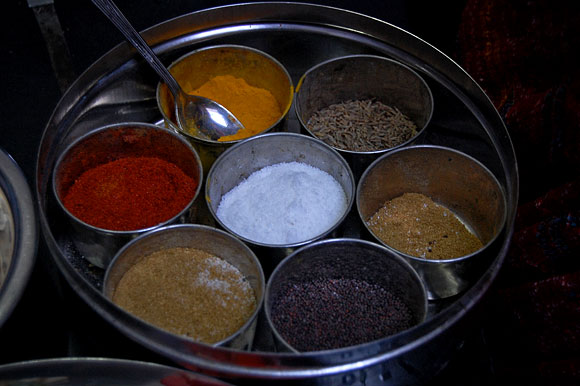
The staple Indian spices.
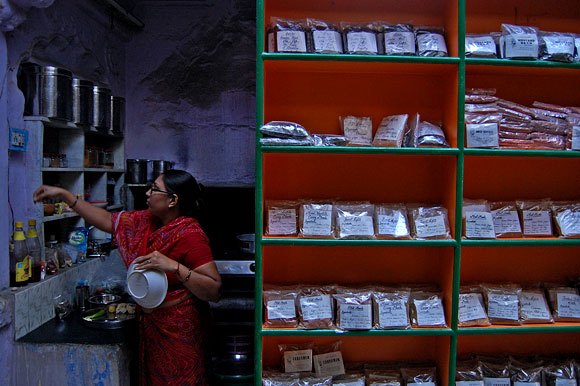
Our host in her kitchen.
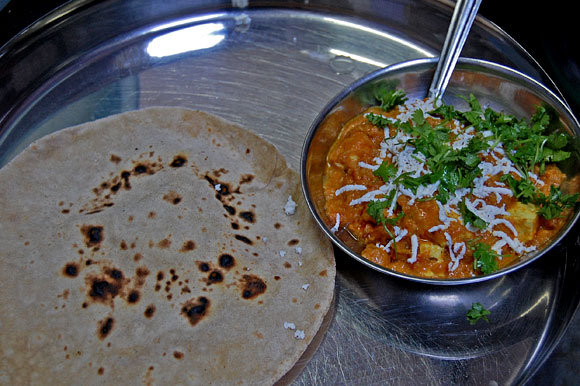
One of the paneer curries and paratha.
After another sweaty night of sleep, we got off to a later start. Breakfast, then exploration. J.’s feet started hurting around lunch, so she took the key and walked home. I found a group of men sitting around a tree drinking chai. The vendor gave me a dainty ceramic cup and I sat down. They weren’t inclined to include me in their Hindi conversation, but we nodded hello. I watched from the edge and enjoyed the delicious spicy brew from the filthiest looking contraption. When I got up to pay, the owner gestured that it was free. I thanked him and walked away.
Walking around town alone felt much different. Fewer people said hello. I almost felt invisible. Before heading back, I stopped for a pineapple shake and a lemon soda. The soda was spiced up and salty. Weird but good. It was time to freshen my breath with a pack of Tojo Brand tangy mouth freshener.

The contents of a pack of breath freshening things: dates, fennel, coriander seeds, silver coated cardamom seeds, saffron, coconut, sweetener, herbs. Each pack cost 1Rs(2¢).
That evening, we were to meet a friend of a friend from work. He was arriving from Dehli; we planned to meet around 8 for a drink. Our meeting point was the clocktower. When we walked up, a confidant man stepped out of a shiny black car and came up to me. We shook hands. Once again, I was meeting a different echelon of India society. He asked if we would like to walk to get a drink, and we said sure. He signaled to his driver and the man got in the car and drove away. We walked past our guesthouse and down another street and stopped at an old gate. It was the very same gate I had photographed earlier.
He explained that they were building a luxury hotel on a large parcel of land behind the gate. The gate opened, and we went in. The property was vast and under construction. A few new buildings had been built and three other multiple hundred year old buildings were getting restored. Scaffolding and commotion were everywhere. As he led around, I felt like Indian Jones getting led around some exotic archaeologic site. Towering over everything was the massive hill and fort, dimly flowing from the lights of the city. After the tour, he led us to the rooftop of one of the older buildings. Set out were table and chairs, cold beer, and snacks. They were waiting for us. We chatted for a while and party ways. The evening left the lingering tastes of power, history, and beer on my mind.
We are leaving Jodhpur tomorrow morning to ride some camels and stay the night in a nearby town called Osiyan. We decided to skip Jaisalmer for somewhere closer. Until then.
7 Comments
i nominate ‘bird on a bike’ for Picture of the Set. though its got a lot of competition.
October 8th, 2008 at 10:11 ami love bird on bike too! beautiful photos overall. the food you made looks delicious too. mm.
October 8th, 2008 at 10:40 amI also like bird on a bike. I was sad to leave that town, but I think I’ve upgraded by going to Udaipur.
October 9th, 2008 at 8:17 amOh wow Nik.
Your photos are simply amazing and inspiring— make me want to hop on plane right now.
I can’t wait to see and read more.
Thanks Zaza.
October 20th, 2008 at 11:47 pmHey Nik,
First off, amazing photos. Also, I have a strange request. I’m wondering if there’s a chance I could get a higher resolution copy of the bird on the bike from you. I know that you might have your reservations, but if you could e-mail me, I’d be happy to explain in more detail. It’s a personal project and nothing more.
Thanks,
Paul
November 4th, 2010 at 9:20 pm

i think i’m going to have to get indian food for lunch now… alu gobi matar here i come!
October 8th, 2008 at 7:39 am